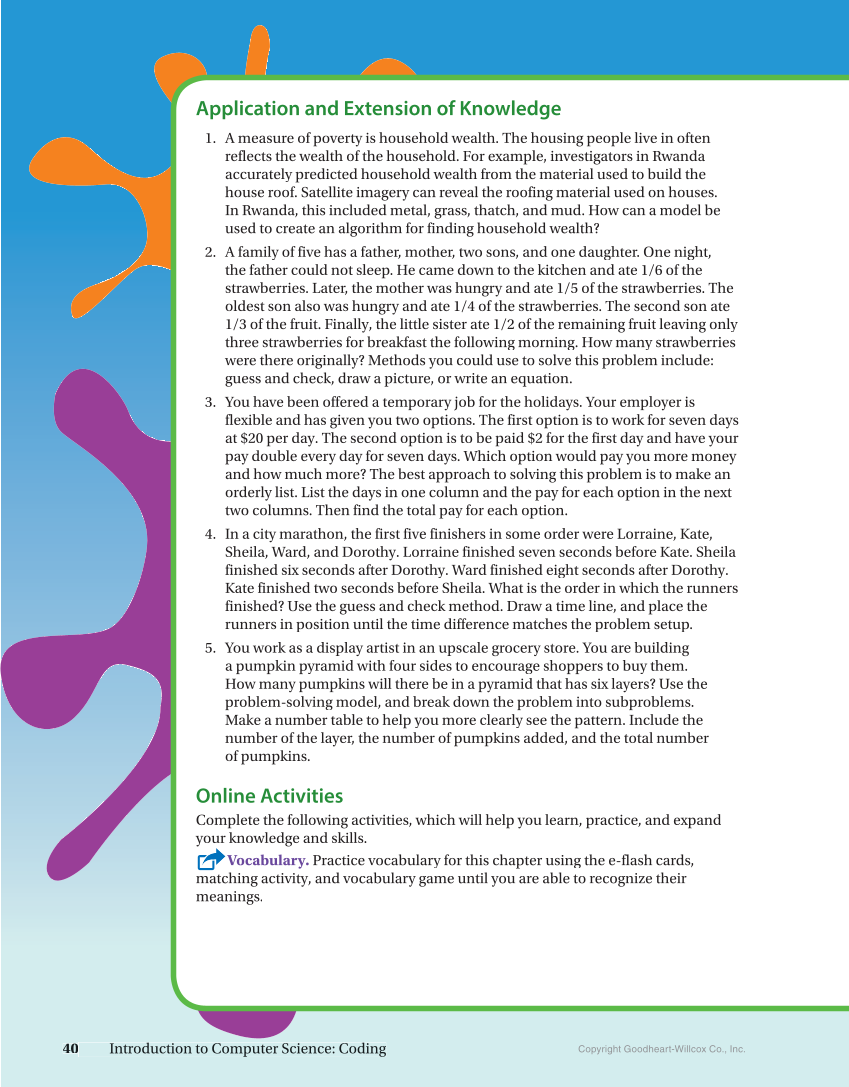Application and Extension of Knowledge 1. A measure of poverty is household wealth. The housing people live in often reflects the wealth of the household. For example, investigators in Rwanda accurately predicted household wealth from the material used to build the house roof. Satellite imagery can reveal the roofing material used on houses. In Rwanda, this included metal, grass, thatch, and mud. How can a model be used to create an algorithm for finding household wealth? 2. A family of five has a father, mother, two sons, and one daughter. One night, the father could not sleep. He came down to the kitchen and ate 1/6 of the strawberries. Later, the mother was hungry and ate 1/5 of the strawberries. The oldest son also was hungry and ate 1/4 of the strawberries. The second son ate 1/3 of the fruit. Finally, the little sister ate 1/2 of the remaining fruit leaving only three strawberries for breakfast the following morning. How many strawberries were there originally? Methods you could use to solve this problem include: guess and check, draw a picture, or write an equation. 3. You have been offered a temporary job for the holidays. Your employer is flexible and has given you two options. The first option is to work for seven days at $20 per day. The second option is to be paid $2 for the first day and have your pay double every day for seven days. Which option would pay you more money and how much more? The best approach to solving this problem is to make an orderly list. List the days in one column and the pay for each option in the next two columns. Then find the total pay for each option. 4. In a city marathon, the first five finishers in some order were Lorraine, Kate, Sheila, Ward, and Dorothy. Lorraine finished seven seconds before Kate. Sheila finished six seconds after Dorothy. Ward finished eight seconds after Dorothy. Kate finished two seconds before Sheila. What is the order in which the runners finished? Use the guess and check method. Draw a time line, and place the runners in position until the time difference matches the problem setup. 5. You work as a display artist in an upscale grocery store. You are building a pumpkin pyramid with four sides to encourage shoppers to buy them. How many pumpkins will there be in a pyramid that has six layers? Use the problem-solving model, and break down the problem into subproblems. Make a number table to help you more clearly see the pattern. Include the number of the layer, the number of pumpkins added, and the total number of pumpkins. Online Activities Complete the following activities, which will help you learn, practice, and expand your knowledge and skills. Vocabulary. Practice vocabulary for this chapter using the e-flash cards, matching activity, and vocabulary game until you are able to recognize their meanings. 40 Introduction to Computer Science: Coding Copyright Goodheart-Willcox Co., Inc.
